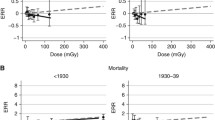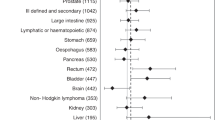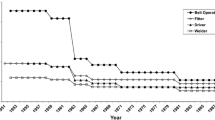Abstract
The possible mortality risk from low level chronic exposures to ionizing radiation was evaluated among 143,517 United States radiologic technologists certified by the American Registry of Radiologic Technologists between 1926-80. This is one of the few occupational studies of primarily women (73 percent) exposed to radiation during their employment. More than 2.8 million person-years of follow-up were accrued through 1990, and 7,345 deaths were identified. A strong healthy-worker effect was observed (standardized mortality ratios [SMR] for all causes and all cancers were 0.69 and 0.79, respectively). Lung cancer (429 deaths) was not increased with available measures of radiation exposure and no significant associations were observed for acute, myelogenous, and monocytic leukemia (74 deaths). Relative to the general population, the standardized mortality ratio (SMR) for female breast cancer was 0.99 (based on 425 deaths); however, breast cancer was significantly elevated relative to all other cancers in a test of homogeneity of SMRs (ratio of SMRs = 1.3, P < 0.0001). Significant risks were correlated with employment before 1940 (SMR = 1.5; 95 percent confidence interval [CI] = 1.2-1.9), when radiation doses were likely highest, and among women certified for more than 30 years (SMR = 1.4, CI = 1.2-1.7) for whom the cumulative exposure was likely greatest. Using an internal referent group, risk increased with duration of certification among the 1,890 women certified before 1940 (P-trend < 0.001). While the findings for breast cancer are consistent with a radiation effect, possible misclassification in exposure (based on number of years certified) and potential confounding associated with reproductive histories preclude a causal conclusion.
Similar content being viewed by others
References
United Nations Scientific Committee on the Effects of Atomic Radiation. Genetic and Somatic Effects of Ionizing Radiation. New York, NY (USA): United Nations, 1986; Pub. E.86.IX.9.
United Nations Scientific Committee on the Effects of Atomic Radiation. Sources and Effects of Ionizing Radiation. New York, NY (USA): United Nations, 1993; Pub. E.94.IX.2.
Jablon S, Miller RW. Army technologists: 29-year follow up for cause of death. Radiology1978; 126: 677–9.
March HC. Leukemia in radiologists. Radiology1944; 43: 275–8.
Lewis EB. Leukemia, multiple myeloma, and aplastic anemia in American radiologists. Science1963; 142: 1492–4.
Smith PG, Doll R. Mortality from cancer and all causes among British radiologists. Br J Radiol1981; 54: 187–94.
Matanoski GM, Sternberg A, Elliott EA. Does radiation exposure produce a protective effect among radiologists? Health Phys1987; 52: 637–43.
Wang JX, Inskip PD, Boice JD Jr, Li BX, Zhang JY, Fraumeni JF Jr. Cancer incidence among medical diagnostic x-ray workers in China, 1950 to 1985. Int J Cancer1990; 45: 889–95.
Gilbert ES, Cragle DL, Wiggs LD. Updated analyses of combined mortality data for workers at the Hanford Site, Oak Ridge National Laboratory, and Rocky Flats Weapons Plant. Radiat Res1993; 136: 408–21.
Cardis E, Gilbert ES, Carpenter L, et al. Effects of low doses and low dose rates of external ionizing radiation: Cancer mortality among nuclear industry workers in three countries. Radiat Res1995; 142: 117–32.
Boice JD Jr, Mandel JS, Doody MM, Yoder RC, McGowan R. A health survey of radiologic technologists. Cancer1992; 69: 586–98.
Boice JD Jr, Mandel JS, Doody MM. Breast cancer among radiologic technologists. J Am Med Assoc1995; 274: 394–401.
Doody MM, Mandel JS, Boice JD Jr. Employment practices and breast cancer among radiologic technologists. J Occup Environ Med1995; 37: 321–7.
tNational Center for Health Statistics. International Classification of Diseases, Adapted for Use in the United States, Eighth Revision. Washington, DC: US Government Printing Office, 1967; USPHS Pub. No. 1693.
Monson RR. Analysis of relative survival and proportional mortality. Comput Biomed Res1974; 7: 325–32.
Breslow NB, Day NE. Statistical Methods in Cancer Research. Lyon, France: International Agency for Research on Cancer, 1987; IARC Sci. Pub. No. 82.
Breslow NB, Lubin JH, Marek P, Langholz B. Multiplicative models and cohort analysis. J Am Stat Assoc1983; 78: 1–12.
Preston DL, Lubin JH, Pierce DA. EPICURE User's Guide. Seattle, WA (USA): Hirosoft International Corporation, 1993.
United Nations Scientific Committee on the Effects of Atomic Radiation. Sources and Effects of Ionizing Radiation. New York, NY (USA): United Nations, 1994; Pub. E.94.IX.11.
Pierce DA, Shimizu Y, Preston DL, Vaeth M, Mabuchi K. Studies of the mortality of atomic bomb survivors. Report 12, Part I. Cancer: 1950-1990. Radiat Res1996; 146: 1–27.
Weiss HA, Darby SC, Fearn T, et al. Leukemia mortality after x-ray treatment for ankylosing spondylitis. Radiat Res1995; 142: 1–11.
van Leeuwen FE, Somers R, Taal BG, et al. Increased risk of lung cancer, non-Hodgkin's lymphoma, and leukemia following Hodgkin's disease. J Clin Oncol1989; 7: 1046–58.
Inskip PD, Stovall M, Flannery JT. Lung cancer risk and radiation dose among women treated for breast cancer. J Natl Cancer Inst1994; 86: 983–8.
Davis FG, Boice JD Jr, Hrubec Z, et al. Cancer mortality in a radiation-exposed cohort of Massachusetts tuberculosis patients. Cancer Res1989; 49: 6130–6.
Howe GR. Lung cancer mortality between 1950 and 1987 after exposure to fractionated moderate-dose-rate ionizing radiation in the Canadian fluoroscopy chart study and a comparison with lung cancer mortality in the atomic bomb survivor study. Radiat Res1995; 142: 295–304.
Boice JD Jr, Preston D, Davis FG, Monson RR. Frequent chest X-ray fluoroscopy and breast cancer incidence among tuberculosis patients in Massachusetts. Radiat Res1991; 125: 214–22.
Fraumeni JF Jr, Lloyd JW, Smith EM, Wagoner JK. Cancer mortality among nuns: role of marital status in etiology of neoplastic disease in women. J Natl Cancer Inst1969; 42: 455–68.
Author information
Authors and Affiliations
Rights and permissions
About this article
Cite this article
Doody, M.M., Mandel, J.S., Lubin, J.H. et al. Mortality among United States radiologic technologists, 1926-90. Cancer Causes Control 9, 67–75 (1998). https://doi.org/10.1023/A:1008801404245
Issue Date:
DOI: https://doi.org/10.1023/A:1008801404245




